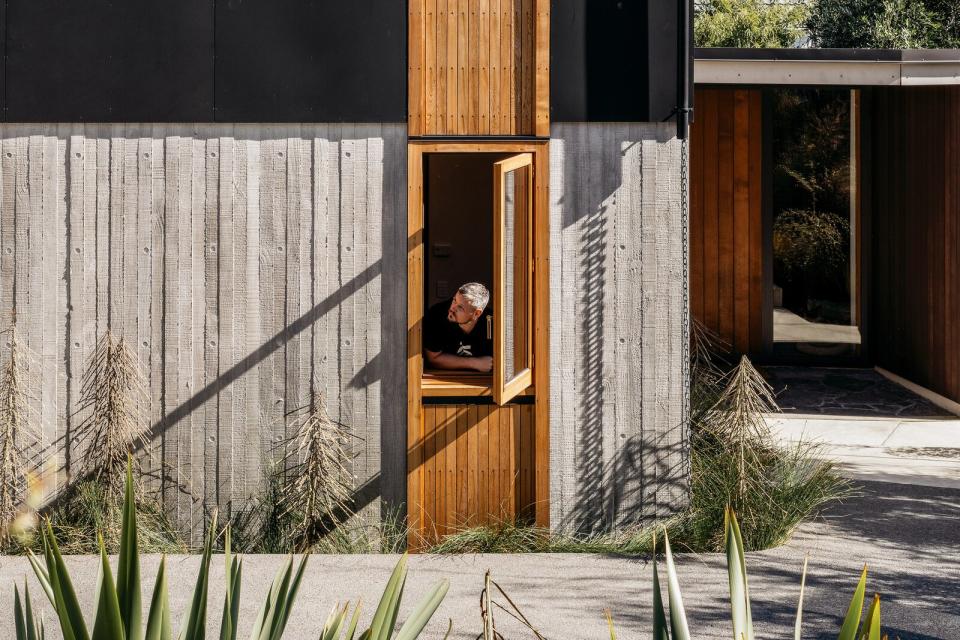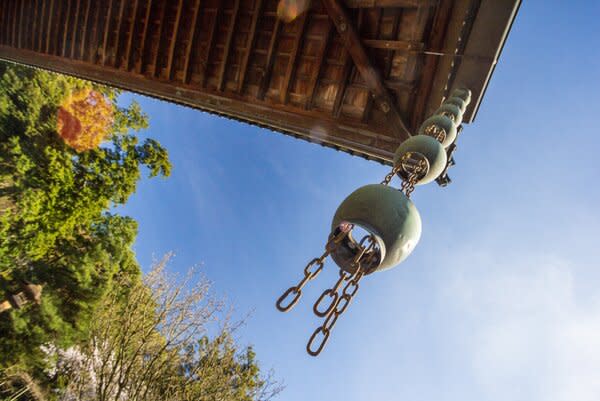Is a Rain Chain Right For You?
Replacing your downspout could improve both the aesthetics and the ecology of your outdoor space—but there are some things to consider before you do.

If you’ve been browsing design trends for 2024, you’ve probably seen a few rain chains. These attractive, functional chains resemble wind chimes—but instead of turning a blustery day into beautiful music, a rain chain turns falling water into a fluid sculpture.
"I adore incorporating rain chains into landscapes," says Amy Hovis, an Austin, Texas landscape designer with a focus on native plants. "Celebrating the rain and the flow of water rather than hiding it in a downspout is truly enjoyable, and a rain chain beautifully embodies this ethos. Whenever I see a conventional downspout, especially at the front entrance to a home, I can't help but envision a charming rain chain in its place."
While rain chains can technically be installed anywhere, they are most often placed at the ends of gutters in lieu of the traditional downspout. If you already know you like the look of a rain chain, then there are other questions you might want to consider—including whether a rain chain is appropriate for your region.
"Rain chains are something you see more of in the Pacific Northwest," explains Mark A. Sullivan, a partner with New Jersey-based integrated design firm JZA+D. "These are regions that typically experience soft rainfall and few or zero deluge rain storms. If the rainfall is too heavy, the water may splash off the ground at the end of the chain and onto the side of the home, potentially leading to rot."
With that in mind, here’s everything you need to know about rain chains—including whether you might need one.
What is a rain chain?
There’s a rain chain out there for every aesthetic, but the basics are the same: a set of linked elements that provide a guided path for rainwater and gutter runoff. What that looks like is completely up to you.
"Rain chains are a bit like jewelry for your gutter," explains Sonya Query, a Master Gardener and Marketing Director for Love, Plants, Inc. "Made of linked chains or cups, rainwater trickles down creating a soothing sound and can prevent heavy rainfall from splashing harshly on the ground. They’re often used in Japanese gardens, adding a touch of zen and visual interest. They’re also popular with rainwater harvesters."
How do rain chains benefit the environment?
There are many different ways in which a rain chain can improve the ecology of your backyard. If you are interested in collecting rainwater, for example, a rain chain can be an attractive and functional way to transfer rainfall into a barrel or storage container.
Some landscape designers use rain chains to direct water into ponds or fountains, reducing the amount of water that needs to be provided from other sources. Hovis, for example, likes to use rain chains to direct water towards outdoor water gardens. "One of my favorite touches is featuring plants that thrive in heavy rainfall, which can enhance the aesthetic and ecological appeal."
Where can you buy a rain chain?
While rain chains are sold pretty much anywhere you can find garden implements—including Amazon, Walmart and Etsy—you may want to take advantage of the functional expertise offered at your local home and garden retailer.
"Garden stores that also carry garden decor and accessories are a great place to start," says Query. "They're especially likely to carry rain chains if you live in a wetter climate. Home improvement and hardware stores are another good bet. Home decor or furniture retailers that carry outdoor lines are also an option for higher end versions."
As the owner of both Eden Garden Design and Barton Springs Nursery, Hovis understands the importance of investing in quality materials. "I recommend opting for a sturdy, substantial option such as a heavy chain in rusted steel, bronze or stainless, or one with simple cups to elegantly channel the water downwards. Beware of thinner, less durable options available online."
How do you install a rain chain?
Installing a rain chain is relatively straightforward, especially if you’re already familiar with the way your home gutter system works.
"Remove your current downspout where you want your rain chain," explains Query. "Then attach a gutter reducer. This narrows the opening and directs water onto the chain."
Although you can install a rain chain into a soffit instead of a gutter, our experts don’t recommend it. "You don’t want to put a hole in your roof or soffit," says Hovis. "You want to attach a rain chain to a gutter so that the water flows from the gutter to the chain. You can remove a downspout and add a fitting. It’s really easy."
Query agrees. "Most rain chains come with a V-shaped hook that slips into the gutter hole," she told us. "Anchor the bottom of the rain chain to prevent it from getting caught in wind, and add a basin or stones at the bottom for splash control."
Some people choose to anchor the loose end of their rain chain to a barrel that can help them harvest rain water. Other people attach their rain chain to a water feature, rock sculpture, garden stake, drainage grate or a similarly solid object. Pick something that can handle a little rainfall, of course—because if everything works as planned, it’ll get plenty.
Can you make your own rain chain?
People who are creatively inclined may be able to craft their own rain chain, as long as they understand the fundamentals of its construction.
"Decide how long you need your rain chain to be, from gutter to ground," says Query. "Use copper, stainless steel, or even recycled items like spoons or small pots. Then use wire to connect your chosen items, ensuring they have a way to funnel or catch water."
Rain chains work based on the principles of surface tension, which means that the water does not necessarily fall directly from one element of the chain to another. Instead, water travels down the links that connect each element, clinging to the chain as it goes. A well-constructed rain chain maintains this surface tension throughout the entire structure, allowing water to travel where you want it. That said, heavy rainfalls and strong winds may cause some of the water to splash out of the chain—so make sure you don’t put your rain chain too close to any backyard items that can’t get too wet.
How do you deal with rain chain runoff?
"Water doesn’t care what path it follows, whether downspout or rain chain," says Alexander Zilberman, architect and founder of Alexander Zilberman Architecture in New York. "When you’re working with a rain chain you have to consider the solution for runoff in the same spirit as you would for a downspout. In other words, finding a solution for the water at the end of its path."
This solution could be a rain barrel, a rock garden or a drainage grate—but you need something, and you need to think about how it will catch and transfer the water.
"The rain chain should drain into an area where it can be dispersed without creating erosion," explains Matthew Bowles, founder of San Francisco-based architecture and design studio TENBOOKS. "Ideally, the water flows into a garden or planter. Make sure it drains into a dissipator first such as into a pile of rocks, or onto a splash block. This will prevent the running water from eroding the soil."
What happens if your rain chain clogs?
If you’re worried about whether your rain chain might clog, our experts reassured us it wouldn’t be a problem.
"The rain chain shouldn’t clog," says Hovis. "If there’s an issue, it would be at the gutter." This may require you to clean out the gutter, but you should be cleaning your gutters on a regular basis anyway—so make sure you add that task to your to-do list.
Zilberman agrees. "A rain chain doesn’t really clog like a gutter or downspout might. When something gets stuck in a rain chain, it’s a lot easier to remove because it's exposed," he told us. "You can just reach to pull it off by hand."
Are rain chains better than downspouts?
While all of the experts we talked to agreed that rain chains can add beauty and functionality to certain types of architectural landscapes, they didn’t necessarily agree that rain chains are better than downspouts.
Bowles was the most positive. "Rain chains can function better than downspouts because they slow down the water and reduce erosion. They can also be architecturally intriguing and add a design element to the space."
Hovis qualified her answer somewhat. "They are different," she said. "They are both needed. I use rain chains in special key areas, where you see them and downspouts in the other corners of a home to really get the water out and direct it to plants or capture the water to take it somewhere else."
Zilberman gave us a list of pros and cons. "I’m in favor of rain chains so long as they harmonize with the composition of the particular facade design," he told us. "The main reason I favor them is the visual connection with the water as it follows its natural path downward to the soil. Rain chains work especially well with designs that celebrate the home's architectural components rather than those where the components are concealed."
That said, he acknowledged that the installation could be more complicated than some people realize. "The downside of rain chains is that they require a customized, even bespoke installation, as opposed to downspouts which are more standardized and you can just hire a typical gutter installer," Zilberman concluded. "I prefer the investment of thought and technique behind rain chains."
We love the products we feature and hope you do, too. If you buy something through a link on the site, we may earn an affiliate commission.
Top photo originally found in A Bunker-Like Typography Studio Springs Up Beside a New Zealand Home
Related Reading:
Rain Chains and Water Catchment Systems to Get You Ready for Spring


